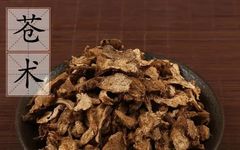|
Cang Zhu (Atractylodes) has a pungent and bitter taste. It is effective in dispelling dampness, strengthening the spleen, expelling wind, and alleviating cold. It is used to treat symptoms such as abdominal distension, indigestion, loss of appetite, fatigue, edema, and diarrhea caused by dampness obstructing the spleen and stomach. |
Doctors say:Cang Zhu is the dried rhizome of the Asteraceae plant, either Nan Cang Zhu (南苍术) or Bei Cang Zhu (北苍术). It is thumb-sized, plump, with a brownish skin, and has a strong aroma. It is warm in nature, with a pungent and bitter taste, and enters the spleen, stomach, and liver meridians, exhibiting effects such as drying dampness, strengthening the spleen, dispelling wind, and clearing the eyes.1. Cang Zhu can transform dampness and is good at drying spleen dampness, commonly used clinically for food stagnation in the middle jiao, gastric distension, nausea, vomiting, poor appetite, fatigue, excessive vaginal discharge in women, dampness in the scrotum in men, and sticky stools;2. Cang Zhu has the effect of dispelling wind and cold, can open the pores to induce sweating, and expel wind-cold pathogens from the muscle layer, and is also good at overcoming dampness; thus it can treat wind-cold exterior syndrome and dampness-related conditions, such as headaches from colds, joint pain, and edema;3. Cang Zhu is rich in Vitamin A, which can be used to treat night blindness, and is effective for symptoms such as blurred vision or dryness;4. Cang Zhu has the effect of drying dampness and strengthening the spleen, promoting protein synthesis, has a blood sugar-lowering effect, and is used to treat abdominal distension;5. Cang Zhu contains volatile oils, which can inhibit the secretion of saliva and gastrointestinal secretions, reducing saliva and intestinal fluid secretion, and has an effect against gastrointestinal ulcers.6. Suitable population: patients with night blindness, those with wind-cold colds7. Contraindicated population: those with yin deficiency and internal heat8. Should not be consumed with Xuan Shen (玄参): Cang Zhu should not be used with Xuan Shen as it may affect the efficacy of the medication.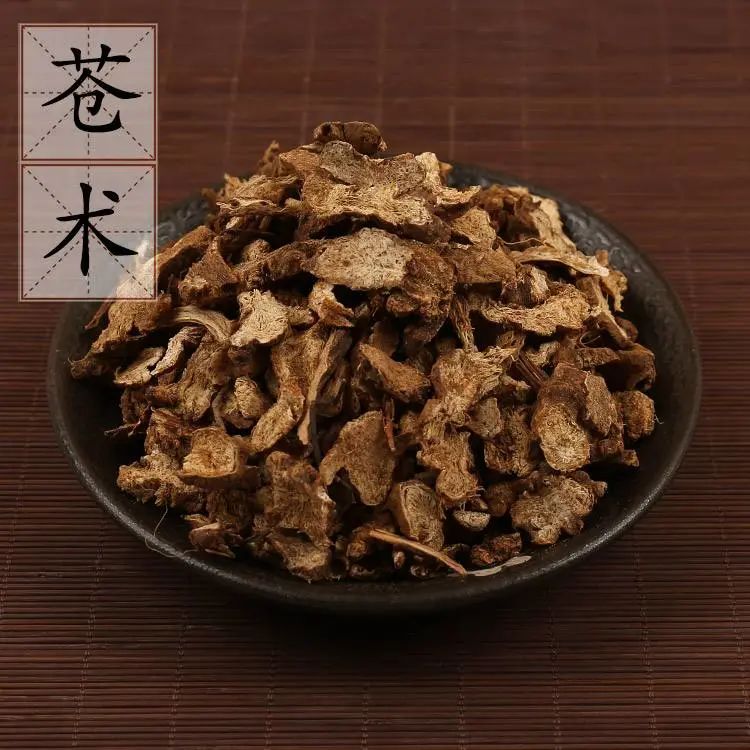 [Pharmacological Knowledge][Alias] Shan Jing, Chi Zhu, Ma Ji, Qing Zhu, Xian Zhu[English Name] Atractylodes Rhizoma. [Composition] Nan Cang Zhu rhizome contains about 5-9% volatile oil. The main components of the oil are Atractylon, Atractylodes alcohol, and β-eucalyptol. Bei Cang Zhu rhizome contains 1.5% volatile oil, with the main components being Atractylon, Atractylodes ketone, Atractylodes alcohol, and eucalyptol. Dong Cang Zhu rhizome contains 1.5% volatile oil, with the main components being Atractylon, Atractylodes alcohol, β-eucalyptol, Atractylodes furan, and Atractylodes ketone.[Processing and Collection] Can be harvested in spring and autumn, with autumn being preferable. After digging up the rhizome, remove the residual stems, fibrous roots, and soil, and dry in the sun.[Identification of Medicinal Materials] ① Nan Cang Zhu is the dried rhizome of the plant Nan Cang Zhu, cylindrical in shape, with a bead-like appearance, has nodes, is curved, about 3-10 cm long, and 1-1.5 cm in diameter. The surface is gray-brown, with root scars and short fibrous roots, and visible stem remnants. It is solid, with a flat break surface, yellow-white in color, and has distinct reddish-brown oil glands scattered, commonly referred to as “vermilion dots”. If exposed for a while, it may produce fine needle-like crystals resembling white mold, with a fragrant aroma and a slightly sweet and bitter taste. The best quality is characterized by being large, solid, hairless, with vermilion dots, and a white frost appearance when cut open. Mainly produced in Jiangsu, Hubei, and Henan. Additionally, Zhejiang, Anhui, and Jiangxi also produce it. The best quality comes from the Maoshan area in Jiangsu, hence called “Ma Zhu” or “Maoshan Cang Zhu”; those distributed in Nanjing are also called “Jing Ma Zhu” or “Jing Cang Zhu”. The products from Hubei and Jiangxi are mostly distributed in Hankou, hence also called “Han Cang Zhu”,
[Pharmacological Knowledge][Alias] Shan Jing, Chi Zhu, Ma Ji, Qing Zhu, Xian Zhu[English Name] Atractylodes Rhizoma. [Composition] Nan Cang Zhu rhizome contains about 5-9% volatile oil. The main components of the oil are Atractylon, Atractylodes alcohol, and β-eucalyptol. Bei Cang Zhu rhizome contains 1.5% volatile oil, with the main components being Atractylon, Atractylodes ketone, Atractylodes alcohol, and eucalyptol. Dong Cang Zhu rhizome contains 1.5% volatile oil, with the main components being Atractylon, Atractylodes alcohol, β-eucalyptol, Atractylodes furan, and Atractylodes ketone.[Processing and Collection] Can be harvested in spring and autumn, with autumn being preferable. After digging up the rhizome, remove the residual stems, fibrous roots, and soil, and dry in the sun.[Identification of Medicinal Materials] ① Nan Cang Zhu is the dried rhizome of the plant Nan Cang Zhu, cylindrical in shape, with a bead-like appearance, has nodes, is curved, about 3-10 cm long, and 1-1.5 cm in diameter. The surface is gray-brown, with root scars and short fibrous roots, and visible stem remnants. It is solid, with a flat break surface, yellow-white in color, and has distinct reddish-brown oil glands scattered, commonly referred to as “vermilion dots”. If exposed for a while, it may produce fine needle-like crystals resembling white mold, with a fragrant aroma and a slightly sweet and bitter taste. The best quality is characterized by being large, solid, hairless, with vermilion dots, and a white frost appearance when cut open. Mainly produced in Jiangsu, Hubei, and Henan. Additionally, Zhejiang, Anhui, and Jiangxi also produce it. The best quality comes from the Maoshan area in Jiangsu, hence called “Ma Zhu” or “Maoshan Cang Zhu”; those distributed in Nanjing are also called “Jing Ma Zhu” or “Jing Cang Zhu”. The products from Hubei and Jiangxi are mostly distributed in Hankou, hence also called “Han Cang Zhu”, 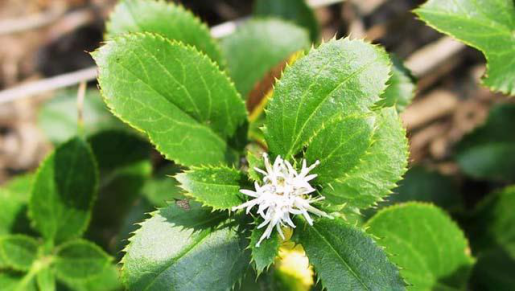 ② Bei Cang Zhu is the dried rhizome of the plant Bei Cang Zhu, cylindrical in shape, often branched or in irregular lumps, about 4-10 cm long, and 1.5-3 cm in diameter. The cork layer is mostly removed, revealing many round stem bases or stem scars, or hairy buds attached, with small root remnants or short roots attached below. The surface is brownish, rough. It is light, easily broken, with a fibrous and uneven break surface. The break surface is yellow-white, with scattered reddish-yellow or yellow oil glands, and distinct woody fiber bundles. It has a fragrant aroma and a slightly bitter taste. The best quality is characterized by being plump, solid, hairless, and aromatic. This species is lighter and less oily than Nan Cang Zhu, with fewer oil glands, and does not produce white mold-like crystals when cut, and has a weaker aroma. Its quality is inferior to that of Nan Cang Zhu. Mainly produced in Inner Mongolia, Hebei, Shanxi, Liaoning, Jilin, and Heilongjiang. Additionally, Shandong, Shaanxi, and Gansu also produce it. The products from Hebei are mostly distributed in Tianjin, hence called “Jin Cang Zhu”.[Pharmacological Effects] ① The effect on blood sugar has been reported that the extract of Nan Cang Zhu (equivalent to 6 grams of raw medicine per kilogram) can lower blood sugar in rabbits, but this has not been confirmed. Oral or subcutaneous injection of decoction or alcohol extract at 8 grams per kilogram tends to slightly increase blood sugar in normal rabbits. The same result was obtained with a decoction of 10 grams per kilogram. However, when the same dosage was administered to alloxan-induced diabetic rabbits, blood sugar slightly increased and then decreased below the pre-treatment level, but the difference was not significant. After 10 days of daily administration, blood sugar continuously decreased, with a significant difference (from 401 to 160 mg%). After stopping the medication for 4-17 days, blood sugar did not rise to the pre-treatment level. ② Other effects: A decoction of Nan Cang Zhu at 10-40 grams per kilogram administered to rats showed no diuretic effect; however, it had a significant salt excretion (sodium, potassium, chloride) effect. A compound containing Cang Zhu – the Gas-Expelling Decoction (Cang Zhu, Hou Po, Tai Wu, Chen Xiang, Guang Mu Xiang, Chao Mai Ya, and Guang Pi) had no effect on isolated rabbit intestines, but stimulated intestinal peristalsis in situ in dogs, whether administered orally or intravenously, and has been clinically effective for treating abdominal distension. A small amount of Cang Zhu extract administered intravenously caused a slight increase in blood pressure in rabbits, while a large amount caused a decrease; it had an inhibitory effect on isolated toad hearts; and also had an inhibitory effect on isolated rabbit duodenum; the effect on toad hind limb blood vessels was weak. The smoke from Cang Zhu and Ai Ye (mugwort) has significant sterilization effects against Mycobacterium tuberculosis, Staphylococcus aureus, Escherichia coli, Bacillus subtilis, and Pseudomonas aeruginosa, similar to formaldehyde; and superior to ultraviolet and lactic acid disinfection.[Preparation] Cang Shui: Remove impurities, soak in water until 70-80% translucent, take out, let it soak through, slice, and dry. Fried Cang Zhu: Take Cang Zhu slices, moisten with rice wash water, and fry in a pot over low heat until slightly yellow; or take cleaned Cang Zhu, soak in rice wash water, take out, steam until thoroughly cooked, slice, and dry. ① “Compendium of Materia Medica”: “Cang Zhu is dry in nature, so it is soaked in glutinous rice wash to remove its oil, sliced, and dried for use; it can also be fried with sesame oil to reduce its dryness.” ② “Essentials of Materia Medica”: “Cang Zhu should be soaked in rice wash until extremely clean, scraped of skin, and steamed with black beans. It can also be steamed with honey wine or human milk to moisten it and prevent it from being too dry. During the three steaming processes, it must be thoroughly dried to allow the aroma to penetrate.”[Functions and Indications] Strengthens the spleen, dries dampness, relieves depression, and dispels filth. Treats excessive dampness obstructing the spleen, fatigue, lethargy, abdominal distension, poor appetite, vomiting, diarrhea, dysentery, malaria, phlegm retention, edema, seasonal colds, wind-cold-damp bi syndrome, foot weakness, and night blindness.
② Bei Cang Zhu is the dried rhizome of the plant Bei Cang Zhu, cylindrical in shape, often branched or in irregular lumps, about 4-10 cm long, and 1.5-3 cm in diameter. The cork layer is mostly removed, revealing many round stem bases or stem scars, or hairy buds attached, with small root remnants or short roots attached below. The surface is brownish, rough. It is light, easily broken, with a fibrous and uneven break surface. The break surface is yellow-white, with scattered reddish-yellow or yellow oil glands, and distinct woody fiber bundles. It has a fragrant aroma and a slightly bitter taste. The best quality is characterized by being plump, solid, hairless, and aromatic. This species is lighter and less oily than Nan Cang Zhu, with fewer oil glands, and does not produce white mold-like crystals when cut, and has a weaker aroma. Its quality is inferior to that of Nan Cang Zhu. Mainly produced in Inner Mongolia, Hebei, Shanxi, Liaoning, Jilin, and Heilongjiang. Additionally, Shandong, Shaanxi, and Gansu also produce it. The products from Hebei are mostly distributed in Tianjin, hence called “Jin Cang Zhu”.[Pharmacological Effects] ① The effect on blood sugar has been reported that the extract of Nan Cang Zhu (equivalent to 6 grams of raw medicine per kilogram) can lower blood sugar in rabbits, but this has not been confirmed. Oral or subcutaneous injection of decoction or alcohol extract at 8 grams per kilogram tends to slightly increase blood sugar in normal rabbits. The same result was obtained with a decoction of 10 grams per kilogram. However, when the same dosage was administered to alloxan-induced diabetic rabbits, blood sugar slightly increased and then decreased below the pre-treatment level, but the difference was not significant. After 10 days of daily administration, blood sugar continuously decreased, with a significant difference (from 401 to 160 mg%). After stopping the medication for 4-17 days, blood sugar did not rise to the pre-treatment level. ② Other effects: A decoction of Nan Cang Zhu at 10-40 grams per kilogram administered to rats showed no diuretic effect; however, it had a significant salt excretion (sodium, potassium, chloride) effect. A compound containing Cang Zhu – the Gas-Expelling Decoction (Cang Zhu, Hou Po, Tai Wu, Chen Xiang, Guang Mu Xiang, Chao Mai Ya, and Guang Pi) had no effect on isolated rabbit intestines, but stimulated intestinal peristalsis in situ in dogs, whether administered orally or intravenously, and has been clinically effective for treating abdominal distension. A small amount of Cang Zhu extract administered intravenously caused a slight increase in blood pressure in rabbits, while a large amount caused a decrease; it had an inhibitory effect on isolated toad hearts; and also had an inhibitory effect on isolated rabbit duodenum; the effect on toad hind limb blood vessels was weak. The smoke from Cang Zhu and Ai Ye (mugwort) has significant sterilization effects against Mycobacterium tuberculosis, Staphylococcus aureus, Escherichia coli, Bacillus subtilis, and Pseudomonas aeruginosa, similar to formaldehyde; and superior to ultraviolet and lactic acid disinfection.[Preparation] Cang Shui: Remove impurities, soak in water until 70-80% translucent, take out, let it soak through, slice, and dry. Fried Cang Zhu: Take Cang Zhu slices, moisten with rice wash water, and fry in a pot over low heat until slightly yellow; or take cleaned Cang Zhu, soak in rice wash water, take out, steam until thoroughly cooked, slice, and dry. ① “Compendium of Materia Medica”: “Cang Zhu is dry in nature, so it is soaked in glutinous rice wash to remove its oil, sliced, and dried for use; it can also be fried with sesame oil to reduce its dryness.” ② “Essentials of Materia Medica”: “Cang Zhu should be soaked in rice wash until extremely clean, scraped of skin, and steamed with black beans. It can also be steamed with honey wine or human milk to moisten it and prevent it from being too dry. During the three steaming processes, it must be thoroughly dried to allow the aroma to penetrate.”[Functions and Indications] Strengthens the spleen, dries dampness, relieves depression, and dispels filth. Treats excessive dampness obstructing the spleen, fatigue, lethargy, abdominal distension, poor appetite, vomiting, diarrhea, dysentery, malaria, phlegm retention, edema, seasonal colds, wind-cold-damp bi syndrome, foot weakness, and night blindness.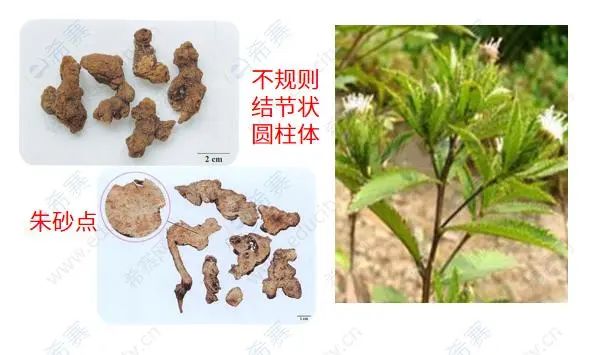 ① Tao Hongjing: “Eliminates foul qi.” ② Liu Wansu: “Brightens the eyes and warms the water organs.” ③ “Pearl Bag”: “Can strengthen the stomach and calm the spleen; no other can eliminate all damp swellings.” ④ Li Gao: “Eliminates dampness, induces sweating, strengthens the stomach, and calms the spleen; a key medicine for treating atrophy.” ⑤ Zhu Zhenheng: “Disperses wind and benefits qi, resolves all stagnation.” ⑥ “Compendium of Materia Medica”: “Treats damp phlegm retention, or with blood stasis forming a mass, and spleen dampness flowing down, turbid discharge, slippery diarrhea, and intestinal wind.” ⑦ “Yuqiu Materia Medica”: “Dries the earth, benefits water, eliminates phlegm, promotes blood circulation, opens stagnation, removes leakage, transforms tinea, eliminates masses, regulates sour swallowing, removes corruption, dispels miasma, and relieves weakness in the muscles and bones, and clears turbid urination.” ⑧ “Materia Medica Seeking Origins”: “Stops water diarrhea, food stagnation, and summer heat diarrhea, and spleen dampness with blood.”[Nature and Taste] Pungent, bitter, warm. ① “Materia Medica Extension”: “The aroma is pungent.” ② “Pearl Bag”: “Sweet and pungent.” ③ “Crystal Essence”: “Bitter and sweet, warm, and non-toxic.” Enters the spleen and stomach meridians. ① “Pearl Bag”: “Foot Yangming, Taiyin.” ② “Compendium of Materia Medica”: “Enters the foot Taiyin, Yangming, hand Taiyin, and Taiyang meridians.” ③ “New Compilation of Materia Medica”: “Enters the foot Yangming and Taiyang meridians.” ④ “Materia Medica Revisited”: “Enters the spleen and liver meridians.”[Dosage and Administration] Internal use: decoction, 4.5-9 grams; can be made into a paste or used in pills or powders. [Precautions] Contraindicated for those with yin deficiency and internal heat, and those with qi deficiency and excessive sweating. ① “Materia Medica Collected Annotations”: “Use with Fang Feng and Di Yu.” ② “Discussion on Medicinal Properties”: “Avoid peaches, plums, sparrow meat, cabbage, and blue fish.” ③ “Introduction to Medicine”: “Use cautiously for those with blood deficiency and emotional distress. Misuse can deplete qi and blood, dry body fluids, and exacerbate internal heat and distension.” ④ “Materia Medica Annotations”: “For diseases belonging to yin deficiency, blood deficiency, insufficient essence, internal heat, dry mouth, cough with phlegm, hemoptysis, epistaxis, throat obstruction, and constipation, it should be avoided. Those with liver and kidney qi movement should not take it.” ⑤ “Materia Medica Corrected”: “Avoid for those with internal heat and yin deficiency, and those with exterior deficiency and sweating.”[Storage] Store in a cool, dry place.[Nature and Taste and Meridians] Pungent, bitter, warm. Enters the spleen, stomach, and liver meridians.[Remarks] (1) Treats dampness obstructing the spleen and stomach, leading to abdominal distension, poor appetite, fatigue, thick white greasy tongue coating, often used in combination with Hou Po and Chen Pi; for treating cold-damp white discharge, it can be used with Bai Zhi. Although this product is warm and drying, it has a strong drying effect on dampness, and is often combined with heat-clearing products to treat damp-heat conditions, such as damp-heat white discharge, and can be used with Zhi Mu, Ku Shen, and Mu Tou Hui; for damp-heat descending, knee swelling and pain, weakness, it can be used with Huang Bai, Niu Xi, and Yi Ren; for damp-warm diseases, it can be used with Shi Gao and Zhi Mu. It is particularly suitable for bi pain with a predominance of cold-dampness, and can be used with Qiang Huo and Du Huo. For symptoms of wind-cold-dampness invasion such as headache, body pain, and absence of sweating, it is often used with Qiang Huo, Xi Xin, and Fang Feng. It has the function of brightening the eyes and is a key medicine for treating night blindness, which can be used in combination with pig liver or sheep liver, and Shi Jue Ming. Additionally, this product has a fragrant aroma and can dispel filth; it is commonly burned indoors with Bai Zhi during the Dragon Boat Festival to dispel epidemics. Recent experiments have confirmed that this method can effectively disinfect and sterilize.[Clinical Applications] Dosage 9-30 grams, decocted in water. Used to treat abdominal distension, diarrhea, edema, beriberi, rheumatic pain, wind-cold colds, and night blindness.[Medicinal Parts] The rhizome of the Asteraceae plants Nan Cang Zhu or Bei Cang Zhu. [Source] “Classified Materia Medica”
① Tao Hongjing: “Eliminates foul qi.” ② Liu Wansu: “Brightens the eyes and warms the water organs.” ③ “Pearl Bag”: “Can strengthen the stomach and calm the spleen; no other can eliminate all damp swellings.” ④ Li Gao: “Eliminates dampness, induces sweating, strengthens the stomach, and calms the spleen; a key medicine for treating atrophy.” ⑤ Zhu Zhenheng: “Disperses wind and benefits qi, resolves all stagnation.” ⑥ “Compendium of Materia Medica”: “Treats damp phlegm retention, or with blood stasis forming a mass, and spleen dampness flowing down, turbid discharge, slippery diarrhea, and intestinal wind.” ⑦ “Yuqiu Materia Medica”: “Dries the earth, benefits water, eliminates phlegm, promotes blood circulation, opens stagnation, removes leakage, transforms tinea, eliminates masses, regulates sour swallowing, removes corruption, dispels miasma, and relieves weakness in the muscles and bones, and clears turbid urination.” ⑧ “Materia Medica Seeking Origins”: “Stops water diarrhea, food stagnation, and summer heat diarrhea, and spleen dampness with blood.”[Nature and Taste] Pungent, bitter, warm. ① “Materia Medica Extension”: “The aroma is pungent.” ② “Pearl Bag”: “Sweet and pungent.” ③ “Crystal Essence”: “Bitter and sweet, warm, and non-toxic.” Enters the spleen and stomach meridians. ① “Pearl Bag”: “Foot Yangming, Taiyin.” ② “Compendium of Materia Medica”: “Enters the foot Taiyin, Yangming, hand Taiyin, and Taiyang meridians.” ③ “New Compilation of Materia Medica”: “Enters the foot Yangming and Taiyang meridians.” ④ “Materia Medica Revisited”: “Enters the spleen and liver meridians.”[Dosage and Administration] Internal use: decoction, 4.5-9 grams; can be made into a paste or used in pills or powders. [Precautions] Contraindicated for those with yin deficiency and internal heat, and those with qi deficiency and excessive sweating. ① “Materia Medica Collected Annotations”: “Use with Fang Feng and Di Yu.” ② “Discussion on Medicinal Properties”: “Avoid peaches, plums, sparrow meat, cabbage, and blue fish.” ③ “Introduction to Medicine”: “Use cautiously for those with blood deficiency and emotional distress. Misuse can deplete qi and blood, dry body fluids, and exacerbate internal heat and distension.” ④ “Materia Medica Annotations”: “For diseases belonging to yin deficiency, blood deficiency, insufficient essence, internal heat, dry mouth, cough with phlegm, hemoptysis, epistaxis, throat obstruction, and constipation, it should be avoided. Those with liver and kidney qi movement should not take it.” ⑤ “Materia Medica Corrected”: “Avoid for those with internal heat and yin deficiency, and those with exterior deficiency and sweating.”[Storage] Store in a cool, dry place.[Nature and Taste and Meridians] Pungent, bitter, warm. Enters the spleen, stomach, and liver meridians.[Remarks] (1) Treats dampness obstructing the spleen and stomach, leading to abdominal distension, poor appetite, fatigue, thick white greasy tongue coating, often used in combination with Hou Po and Chen Pi; for treating cold-damp white discharge, it can be used with Bai Zhi. Although this product is warm and drying, it has a strong drying effect on dampness, and is often combined with heat-clearing products to treat damp-heat conditions, such as damp-heat white discharge, and can be used with Zhi Mu, Ku Shen, and Mu Tou Hui; for damp-heat descending, knee swelling and pain, weakness, it can be used with Huang Bai, Niu Xi, and Yi Ren; for damp-warm diseases, it can be used with Shi Gao and Zhi Mu. It is particularly suitable for bi pain with a predominance of cold-dampness, and can be used with Qiang Huo and Du Huo. For symptoms of wind-cold-dampness invasion such as headache, body pain, and absence of sweating, it is often used with Qiang Huo, Xi Xin, and Fang Feng. It has the function of brightening the eyes and is a key medicine for treating night blindness, which can be used in combination with pig liver or sheep liver, and Shi Jue Ming. Additionally, this product has a fragrant aroma and can dispel filth; it is commonly burned indoors with Bai Zhi during the Dragon Boat Festival to dispel epidemics. Recent experiments have confirmed that this method can effectively disinfect and sterilize.[Clinical Applications] Dosage 9-30 grams, decocted in water. Used to treat abdominal distension, diarrhea, edema, beriberi, rheumatic pain, wind-cold colds, and night blindness.[Medicinal Parts] The rhizome of the Asteraceae plants Nan Cang Zhu or Bei Cang Zhu. [Source] “Classified Materia Medica”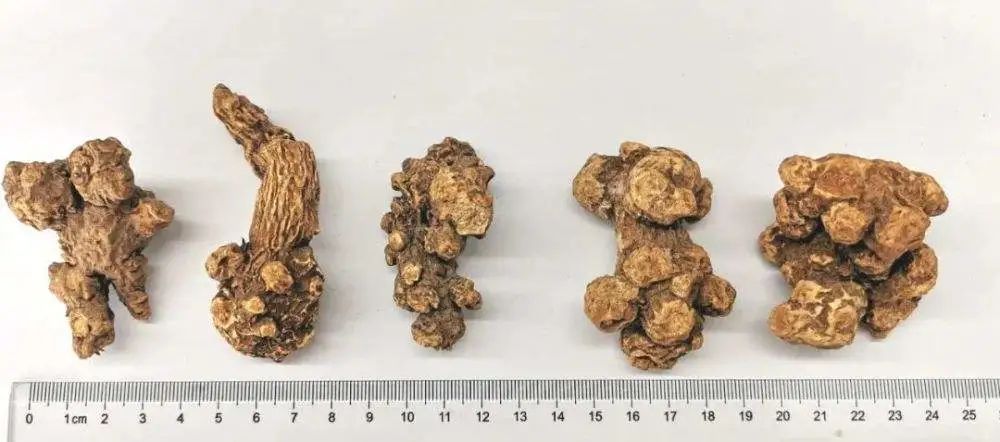 Beauty Efficacy[Beauty Efficacy] Dries dampness, strengthens the spleen, beautifies the skin, and darkens hair.[Beauty Methods] 1. For eczema and facial wind, this product has a pungent taste that can disperse and a bitter taste that can dry, excelling at dispelling dampness. For treating eczema, it can be used with Huang Bai and Long Dan Cao, which are heat-clearing and damp-drying herbs. For treating facial wind, it can be used with fried Huang Bai and ginger juice, i.e., Er Miao San. 2. For aging skin, according to the materia medica, this product “with prolonged use darkens hair and beautifies the skin,” and can be used to treat aging skin, often combined with Fu Ling and Gan Cao, refined with honey into pills, i.e., Cang Zhu Wan from “Pujifang,” taken with warm water. 3. For premature graying of hair, this product can darken hair, and can be used with Chuan Jiao Hong and Xiao Hui Xiang, mixed with rice paste into pills, taken with warm wine, as in “Sheng Ji Zong Lu” Jiao Gan Dan, to treat yellowing or graying hair.[Dosage and Administration] Decoction, 5-10 grams, can also be made into a paste or used in pills or powders. External use as appropriate.
Beauty Efficacy[Beauty Efficacy] Dries dampness, strengthens the spleen, beautifies the skin, and darkens hair.[Beauty Methods] 1. For eczema and facial wind, this product has a pungent taste that can disperse and a bitter taste that can dry, excelling at dispelling dampness. For treating eczema, it can be used with Huang Bai and Long Dan Cao, which are heat-clearing and damp-drying herbs. For treating facial wind, it can be used with fried Huang Bai and ginger juice, i.e., Er Miao San. 2. For aging skin, according to the materia medica, this product “with prolonged use darkens hair and beautifies the skin,” and can be used to treat aging skin, often combined with Fu Ling and Gan Cao, refined with honey into pills, i.e., Cang Zhu Wan from “Pujifang,” taken with warm water. 3. For premature graying of hair, this product can darken hair, and can be used with Chuan Jiao Hong and Xiao Hui Xiang, mixed with rice paste into pills, taken with warm wine, as in “Sheng Ji Zong Lu” Jiao Gan Dan, to treat yellowing or graying hair.[Dosage and Administration] Decoction, 5-10 grams, can also be made into a paste or used in pills or powders. External use as appropriate.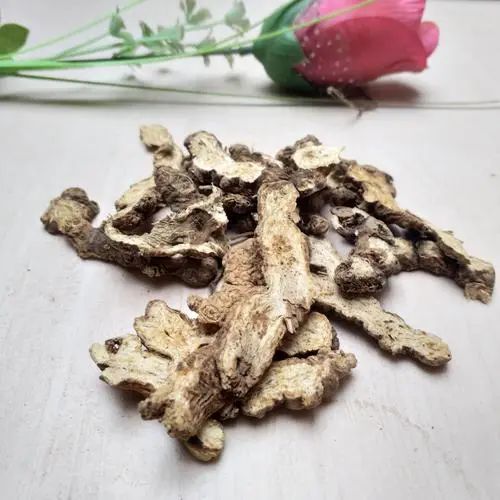 [Usage Precautions] Contraindicated for those with blood deficiency, qi weakness, fluid depletion, and exterior deficiency with spontaneous sweating.[Notes] This product is bitter, warm, and dries dampness, especially good at drying spleen dampness, suitable for treating damp obstruction in the middle jiao, spleen dysfunction leading to abdominal distension, nausea, poor appetite, vomiting, diarrhea, fatigue, and thick white greasy tongue coating. Due to its pungent and bitter nature, it excels at dispelling wind and dampness, thus can be used to treat wind-damp bi syndrome with damp predominance. This product can induce sweating and relieve exterior symptoms, and can be used for exterior wind-cold-dampness invasion. This product is commonly used as a fragrance in modern cosmetics and has preservative properties. Additionally, adding its extract to acne treatments is particularly effective against infectious acne.[Formula] Cang Zhu Wan: Cang Zhu in any amount (soaked in rice wash for three days, changing water daily, then taken out, scraped of skin, sliced, dried, and fried until yellow, finely powdered). For every pound of powder, use half a pound of steamed Fu Ling, refined with honey into pills, the size of wutong seeds. Take fifteen pills, on an empty stomach or before bed with warm water. Alternatively, mix six ounces of Cang Zhu powder with one ounce of Gan Cao powder, mix well, and use as a soup base for Cang Zhu Wan. Darkens hair, beautifies skin, strengthens bones, brightens eyes, dispels wind, moistens skin, and prolonged use makes one light and healthy. (From “Classified Compilation of Zhu’s Verified Formulas”)[Materia Medica Literature] (1) “Shennong’s Materia Medica”: “Making a decoction for prolonged use lightens the body and prolongs life without hunger.” (2) “Pujifang”: “Replenishes deficiency, brightens the eyes, strengthens bones, and harmonizes blood.” (3) “Introduction to Medicine: Materia Medica”: “Prolonged use darkens hair and beautifies skin, strengthens bones, brightens eyes, and moistens skin.” (4) “Pearl Bag”: “Can strengthen the stomach and calm the spirit; no other can eliminate all damp swellings.”
[Usage Precautions] Contraindicated for those with blood deficiency, qi weakness, fluid depletion, and exterior deficiency with spontaneous sweating.[Notes] This product is bitter, warm, and dries dampness, especially good at drying spleen dampness, suitable for treating damp obstruction in the middle jiao, spleen dysfunction leading to abdominal distension, nausea, poor appetite, vomiting, diarrhea, fatigue, and thick white greasy tongue coating. Due to its pungent and bitter nature, it excels at dispelling wind and dampness, thus can be used to treat wind-damp bi syndrome with damp predominance. This product can induce sweating and relieve exterior symptoms, and can be used for exterior wind-cold-dampness invasion. This product is commonly used as a fragrance in modern cosmetics and has preservative properties. Additionally, adding its extract to acne treatments is particularly effective against infectious acne.[Formula] Cang Zhu Wan: Cang Zhu in any amount (soaked in rice wash for three days, changing water daily, then taken out, scraped of skin, sliced, dried, and fried until yellow, finely powdered). For every pound of powder, use half a pound of steamed Fu Ling, refined with honey into pills, the size of wutong seeds. Take fifteen pills, on an empty stomach or before bed with warm water. Alternatively, mix six ounces of Cang Zhu powder with one ounce of Gan Cao powder, mix well, and use as a soup base for Cang Zhu Wan. Darkens hair, beautifies skin, strengthens bones, brightens eyes, dispels wind, moistens skin, and prolonged use makes one light and healthy. (From “Classified Compilation of Zhu’s Verified Formulas”)[Materia Medica Literature] (1) “Shennong’s Materia Medica”: “Making a decoction for prolonged use lightens the body and prolongs life without hunger.” (2) “Pujifang”: “Replenishes deficiency, brightens the eyes, strengthens bones, and harmonizes blood.” (3) “Introduction to Medicine: Materia Medica”: “Prolonged use darkens hair and beautifies skin, strengthens bones, brightens eyes, and moistens skin.” (4) “Pearl Bag”: “Can strengthen the stomach and calm the spirit; no other can eliminate all damp swellings.”
| ===PreviousClassics======Chinese Medicine–Huang JingEffects andFunctions, Qi Supplementation, Yin Nourishment, Spleen Strengthening, Lung Moistening, Kidney BenefitingChinese Medicine–Qian Jin Vine Effects and FunctionsChinese Medicine-Huo XiangEffects and FunctionsArtemisinin Effects and FunctionsChinese Medicine-Blood Supplementing Herb Du Zhong Effects and FunctionsEating MethodsChinese Medicine Collection (1)Health Science CollectionChinese Medicine Ye Jiao Teng Effects and Functions – EatingMethods andContraindicationsSpleen Strengthening Acupoint ExerciseA set of meridian exercises from head to toe, more effective than Sanfu paste! Must-see in summer!Winter diseases treated in summer: removing dampness and treating body cold in summer, remember the “three no’s after meals, three big taboos before sleep”[Recommended] Easy to learn, hands-on guide to cupping (Cupping Comprehensive) |
 Note:Please do not use medication without medical advice.
Note:Please do not use medication without medical advice.

